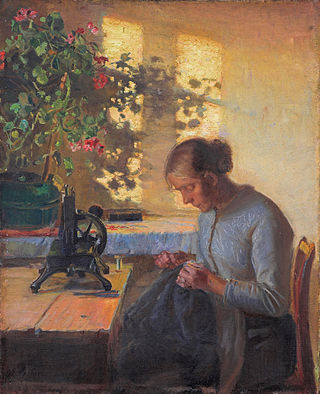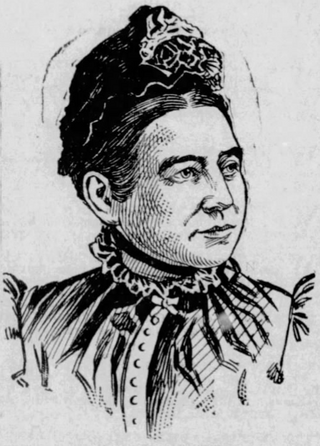
A sewing machine is a machine used to sew fabric and materials together with thread. Sewing machines were invented during the first Industrial Revolution to decrease the amount of manual sewing work performed in clothing companies. Since the invention of the first sewing machine, generally considered to have been the work of Englishman Thomas Saint in 1790, the sewing machine has greatly improved the efficiency and productivity of the clothing industry.

Sewing is the craft of fastening or attaching objects using stitches made with a sewing needle and thread. Sewing is one of the oldest of the textile arts, arising in the Paleolithic era. Before the invention of spinning yarn or weaving fabric, archaeologists believe Stone Age people across Europe and Asia sewed fur and leather clothing using bone, antler or ivory sewing-needles and "thread" made of various animal body parts including sinew, catgut, and veins.

Margaret Eloise Knight was an American inventor, notably of a machine to produce flat-bottomed paper bags. She has been called "the most famous 19th-century woman inventor". She founded the Eastern Paper Bag Company in 1870, creating paper bags for groceries similar in form to the ones that would be used in later generations. Knight received dozens of patents in different fields and became a symbol for women's empowerment.

Elias Howe Jr. was an American inventor best known for his creation of the modern lockstitch sewing machine.

A patent model was a handmade miniature model no larger than 12" by 12" by 12" that showed how an invention works. It was one of the most interesting early features of the United States patent system.

Walter Hunt was an American mechanical engineer. Through the course of his work he became known for being a prolific inventor. He first became involved with mechanical innovations in a linseed producing community in New York state that had flax mills. While in New York City to promote his inventions he got involved in inventing the streetcar gong that was used throughout the United States. This then led him to invent other useful items like the safety pin and sewing machine. He invented the precursor to the repeating rifle and fountain pen. About two dozen of his inventions are used today in basically the same form as he had patented them. In spite of his many useful innovative creations he never became wealthy since he sold off most of his patent rights to others at low prices with no future royalties. Others made millions of dollars from his safety pin device.

Beulah Louise Henry, known as 'Lady Edison,' was an American inventor whose extensive contributions to consumer products and manufacturing technology solidified her legacy in the field. Born in Raleigh, North Carolina,
and later based in New York City, Henry was a pioneering figure who held 49 patents and developed over 110 inventions, significantly advancing technology while breaking gender barriers in her field.
Bernina International AG is a privately owned international manufacturer of sewing and embroidery systems. The company was founded in Steckborn, Switzerland, by a Swiss inventor Fritz Gegauf. The company develops, manufactures, and sells goods and services for the textile market, primarily household sewing-related products in the fields of embroidery, quilting, home textiles, garment sewing, and crafting. The origins of the company lie in the invention of the hemstitch sewing machine, invented in 1893 by a Swiss inventor and entrepreneur Karl Friedrich Gegauf. Currently, the company's products include sewing machines, embroidery machines, serger/overlocker machines, and computer software for embroidery design.

Helen Augusta Blanchard was an American inventor who received 28 patents between 1873 and 1915. She was known for her numerous inventions dealing with sewing machines and sewing technology.

Allen Benjamin Wilson (1823–1888) was an American inventor famous for designing, building and patenting some of the first successful sewing machines. He invented both the vibrating and the rotating shuttle designs which, in turns, dominated all home lockstitch sewing machines. With various partners in the 19th century he manufactured reliable sewing machines using the latter shuttle type.
The Singer Model 27 and later model 127 were a series of lockstitch sewing machines produced by the Singer Manufacturing Company from the 1880s to the 1960s.. They were Singer's first sewing machines to make use of "vibrating shuttle" technology. Millions were produced. They are all steel and cast iron, and were built before the advent of planned obsolescence, and so they were designed to be repaired rather than replaced. Consequently many remain today, some in collections and others still in service. In company literature they were called "the woman's faithful friend the world over".

Myra Juliet Farrell was an Australian visionary, inventor and artist. Born in County Clare, Ireland, she migrated to Australia as a child, growing up in Broken Hill, travelled widely and settled in Mosman, Sydney. She held more than two dozen patents ranging from a military barricade to a press stud that could be applied without stitching.

Mary Beatrice Davidson Kenner was an American inventor most noted for her development of the adjustable sanitary belt. Kenner received five patents, which includes a carrier attachment for invalid walker and bathroom tissue dispenser.
Hannah Slater was an early American pioneer and inventor. Some sources state that she was the first American woman to receive a patent, however others state that Hazel Irwin, who received a patent for a cheese press in 1808, or Mary Kies, in 1809, was the first.
Mary P. Carpenter or Mary P.C. Hooper was an American inventor from Buffalo, New York credited with seventeen patents over her lifetime. She also founded two companies, the "Carpenter Sewing Machine Co." and the "Carpenter Straw Sewing Machine Co.".

Maria E. Beasley was an American entrepreneur and inventor. Born in North Carolina, Beasley grew up with a strong interest in mechanical work and learned about the profession of barrel-making from her grandfather. Between 1878 and 1898, she patented fifteen inventions in the United States: these included a footwarmer, an improved life raft, and an anti-derailment device for trains; however, her primary success as an inventor rose from a specialty in barrel-making machines and processes. Beasley licensed a patent to the Standard Oil Company, exhibited her work at the World's Industrial and Cotton Centennial Exposition and the World's Columbian Exposition, and founded two companies for the design and manufacture of barrels.
Emily Evans Tassey was a 19th century American inventor. Tassey earned patents for five inventions, all related to marine propulsion technology from 1876 to 1880.
Margaret Plunkett Richardson Colvin was a 19th-century inventor. She received four patents over her lifetime, all related to laundry improvements. Colvin's most important invention was the Triumph Rotary Washer which she exhibited at the Philadelphia Centennial in 1876 and the Columbian Exposition in 1893.
Autumn Stanley (1933–2018) researched inventions by women and patents obtained by women in the United States. She is widely known for her book titled, Mothers and Daughters of Invention.

William Chester Ruth was an African American machinist, business owner, and patented inventor who lived in Chester County and Lancaster County, Pennsylvania. The Pennsylvania Historical and Museum Commission dedicated a state historical marker in Ruth's honor in 2006.














